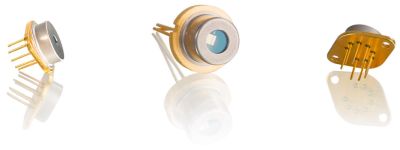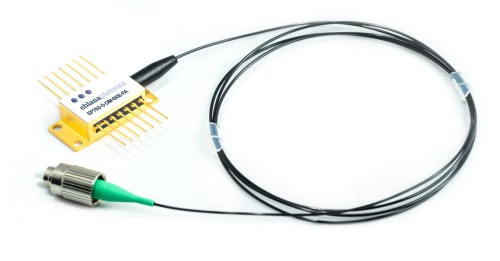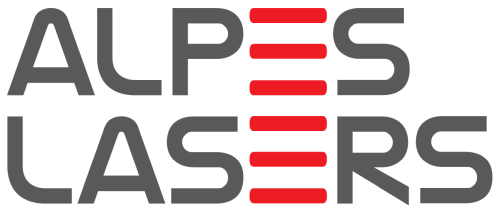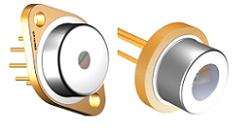Fabry–Pérot laser diodes (original) (raw)
Definition: a laser diode with a laser resonator exhibiting substantial reflections at both ends, but no distributed reflections inside
Alternative term: FP laser diodes
Categories:  optical resonators,
optical resonators,  laser devices and laser physics
laser devices and laser physics
Related: laser diodesdistributed Bragg reflector lasersdistributed feedback lasers
Opposite term: distributed-feedback laser
Page views in 12 months: 2174
DOI: 10.61835/l73 Cite the article: BibTex BibLaTex plain textHTML Link to this page! LinkedIn
Content quality and neutrality are maintained according to our editorial policy.
📦 For purchasing Fabry–Pérot laser diodes, use the RP Photonics Buyer's Guide — an expert-curated directory for finding all relevant suppliers, which also offers advanced purchasing assistance.
Contents
What is a Fabry–Pérot Laser Diode?
A Fabry–Pérot laser diode (FP laser diode) is the most common type of laser diode, having a laser resonator which is a Fabry–Pérot interferometer. This means that substantial light reflections occur at both ends, but not within the gain medium. In contrast, the resonator of a distributed feedback laser exhibits a spectrally more selective distributed reflection throughout the gain medium, usually created by a grating structure.
In the simplest case, the end reflections in a Fabry–Pérot laser are Fresnel reflections at the interface between the semiconductor device structure and air. Note that the refractive index contrast at these locations is quite high, leading to a substantial reflectivity without any additional measures. If that principle is utilized on both sides, the threshold pump power may already be low enough, and about half of the optical output power is obtained at each side.
In order to obtain the total output power on one side, which is usually preferable, or for optimizing the output power via a lower threshold pump power, one often uses a highly reflecting back mirror on the side opposite to the output side — typically a broadband dielectric Bragg mirror structure.
In contrast to the Fabry–Pérot laser, a distributed Bragg reflector laser (DBR laser) uses Bragg mirrors within the semiconductor structure. That makes a difference for the optical function: Dielectric mirrors generally have a much broader reflection bandwidth than semiconductor materials, where the refractive index contrast is usually much lower.
Mode Structure, Beam Quality and Optical Spectrum
A Fabry–Pérot laser diode may emit only on fundamental spatial resonator modes, which leads to a relatively high beam quality, or also on higher-order spatial modes, resulting in a poorer beam quality. The most common example of the latter case is a broad area laser diode. Generally, higher output power (multiple watts) can be achieved when allowing for spatially multimode emission, usually in an active area with increased dimensions.
Even if lasing is restricted to fundamental spatial modes, it will generally occur on multiple longitudinal modes. Despite the relatively short length of the laser resonator, the free spectral range of the resonator may be small enough compared with the gain bandwidth to allow for that phenomenon. (Also, the back mirror is usually not providing substantial frequency selectivity.) As a result, the laser output spectrum exhibits multiple optical frequencies (with a typical spacing of the order of 100 GHz) and is not necessarily stable in shape. It may also happen that emission occurs on a single mode at a time, but temperature changes lead to occasional mode hops to neighboring resonator modes, or also to occasional oscillation on two modes.
For realizing a narrow linewidth laser, one needs to achieve single-mode operation, e.g. by restricting the drive current or the resonator length. (The output can then still contain some weak sub-threshold fluorescence on several other modes.) Another frequently used technique is not to use a Fabry–Pérot design, but instead a distributed Bragg reflector (DFB) design.
Due to the short resonator length, the substantial round-trip losses of the resonator and the moderate intracavity power, the laser linewidth is often substantial (multiple megahertz) even in the case of stable single-mode operation. The linewidth may be substantially reduced by coupling to or integration into an external optical resonator. This leads to the concept of an external-cavity diode laser.
Emission Wavelengths of FP Laser Diodes
Fabry–Pérot laser diodes are available with a very wide range of emission wavelengths from the visible region to the mid- and far-infrared. For the longest output wavelengths, they can be realized as quantum cascade lasers.
Fabry–Pérot Amplifiers
There are also semiconductor optical amplifiers which are realized as Fabry–Pérot amplifiers. Here, relatively weak end reflections are utilized such that the device stays below the laser threshold. Still, those reflections can substantially increase the amplifier gain.
Frequently Asked Questions
This FAQ section was generated with AI based on the article content and has been reviewed by the article’s author (RP).
What is a Fabry–Pérot laser diode?
A Fabry–Pérot laser diode is a common type of laser diode that uses a simple optical resonator, known as a Fabry–Pérot interferometer. This resonator is formed by two parallel reflecting surfaces at opposite ends of the gain medium.
How are the mirrors in a simple Fabry–Pérot laser diode created?
In the simplest design, the mirrors are formed by the natural Fresnel reflection at the cleaved facets of the semiconductor chip. The high refractive index contrast between the semiconductor and the surrounding air creates sufficient reflectivity.
Why does a Fabry–Pérot laser diode typically emit light at multiple frequencies?
Its resonator's free spectral range is often smaller than the gain bandwidth of the semiconductor. This allows the laser to operate on multiple longitudinal modes simultaneously, resulting in an optical spectrum with several distinct frequency peaks.
Can Fabry–Pérot laser diodes produce a high-quality beam?
Yes, if their emission is restricted to the fundamental spatial mode, they can exhibit high beam quality. However, high-power versions like broad area diodes often operate on multiple spatial modes, which results in poor beam quality.
What is a Fabry–Pérot amplifier?
A Fabry–Pérot amplifier is a semiconductor optical amplifier with a structure similar to a Fabry–Pérot laser but operated below its lasing threshold. The weak reflections at the facets are used to significantly increase the amplifier gain.
Suppliers
Sponsored content: The RP Photonics Buyer's Guide contains 32 suppliers for Fabry–Pérot laser diodes. Among them:
⚙ hardware
TOPTICA offers a large variety of wavelength-selected single-mode laser diodes. Among more standard laser diodes you will also find "rarities", i.e. diodes with output wavelengths that only TOPTICA provides. The diodes can be purchased separately. In addition TOPTICA can integrate any diode from the stock lists into a tunable diode laser system: Fabry–Pérot or AR-coated laser diodes may be integrated into a diode laser systems, DFB/DBR laser diodes into a DFB pro and a tapered amplifier into an TA system.
⚙ hardware
Single-mode Fabry–Pérot (FP) laser diodes are precision-engineered by Innolume to emit in a single transverse mode, delivering a high-brightness, diffraction-limited beam — ideal for photonic systems that require stable and high-density optical power.
- available in fiber-coupled and TO-can packages, as well as in C-mounts or on AlN submounts
- continuous-wave output powers of up to 700 mW
- advanced wavelength stability through thermal tuning (±5 nm).
- single-mode or polarization-maintaining fibers with standard or customized connector options (FC/PC, SC/APC, etc.)
This combination of high power, spectral precision, and customizable integration makes Innolume’s FP laser diodes indispensable for applications in sensing, metrology, spectroscopy, and other advanced optical systems.
⚙ hardware
Eblana Photonics designs and manufacture FP laser diodes spanning the NIR to MIR region (650 nm — 12 μm), available in a wide variety of package types and configurations. We leverage our unique epistructure design to deliver a cost effective laser source with high power and excellent spectral characteristics, facilitating applications in free space coms, environmental gas monitoring and beyond.
⚙ hardware
Serving North America, RPMC Lasers offers one of the widest wavelength selections of Fabry–Pérot laser diodes available, ranging from the UV through the IR. These products include fiber-coupled and free-space single-mode diode lasers, multimode single emitters, multi-emitter fiber-coupled modules, laser diode bars, and laser diode stacks. RPMC can provide standard and custom laser diode solutions for any problem. Let us know what you need and we'll help you find it!
⚙ hardware
TOPTICA EAGLEYARD offers different kinds of laser types as single frequency laser diodes. The portfolio comprises a variety of laser and package designs from TO-package to hermetically sealed butterfly packages suitable for industrial applications. Benefit from space-qualifable laser diodes and those that are space-qualified or have space heritage. We offer Distributed Feedback lasers (DFB lasers), Distributed Bragg Reflector lasers (DBR lasers), Rich Waveguide Stabilized lasers (RWS), miniECLs and uMOPA.
⚙ hardware
QPC Lasers full vertical integration from epitaxy through packaging allows us to offer standard and custom diode solutions in packages ranging from mini-mounts to complete OEM light engines that provide performance without compromise.
⚙ hardware
Our broad gain illuminators are Fabry–Pérot lasers designed for maximum width of the gain profile. They can be used as broad spectrum illuminators for spectroscopy or imaging. Combined with an anti-reflection coating, they are suitable for use in an external cavity to obtain a tunable laser with wide tuning range. Their wide and flat gain spectrum can also be suitable to develop frequency combs.
⚙ hardware
The Lumics Fabry—Perot diode laser designs are ideal for OEM integrators developing state-of-the-art end-user laser systems, featuring single emitters with exceptional longevity. Lumics provides single-mode 14-pin BTF lasers for high-precision industrial applications, along with multi-mode diode laser modules available in various sizes, customizable to meet specific customer requirements. Users can specify wavelengths, power levels, and fiber core diameters to ensure the perfect diode laser match for their applications.
⚙ hardware
Sacher Lasertechnik has various kinds of Fabry–Pérot laser diodes which emit spatially single mode.
Available wavelengths are 375–440 nm and 635–1710 nm. Output powers range from 1 mW to 200 mW. The most common types of laser mount are 5.6–mm TO-can and 9–mm TO-can.
Typical geometrical sizes of the laser chip are 1000 µm × 500 µm × 200 µm (length × width × height). Depending on the chip length, Fabry Perot lasers operate longitudinally single- or multimode.
Questions and Comments from Users
Here you can submit questions and comments. As far as they get accepted by the author, they will appear above this paragraph together with the author’s answer. The author will decide on acceptance based on certain criteria. Essentially, the issue must be of sufficiently broad interest.
Please do not enter personal data here. (See also our privacy declaration.) If you wish to receive personal feedback or consultancy from the author, please contact him, e.g. via e-mail.
By submitting the information, you give your consent to the potential publication of your inputs on our website according to our rules. (If you later retract your consent, we will delete those inputs.) As your inputs are first reviewed by the author, they may be published with some delay.
















